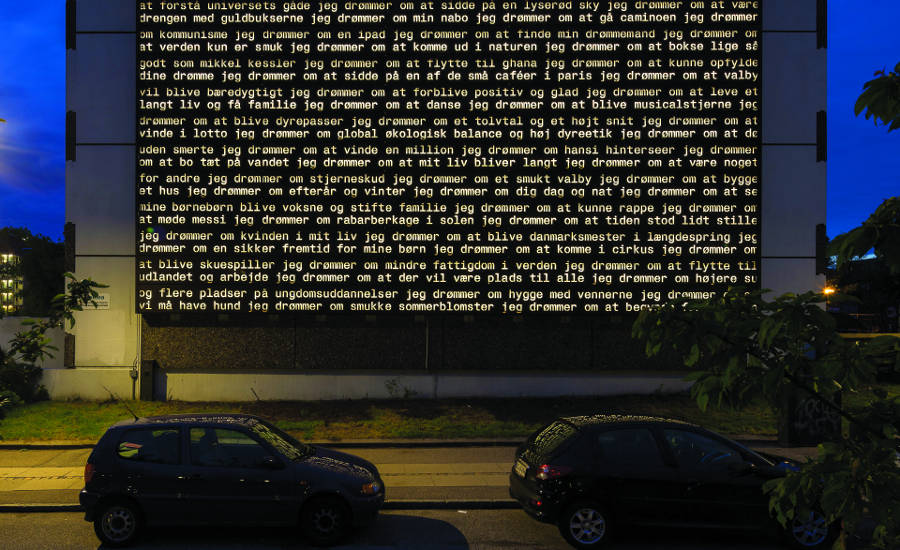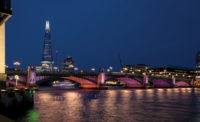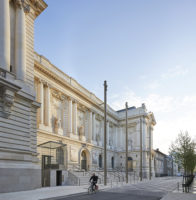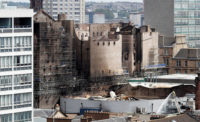Commissioned to create a public artwork as part of a housing-project renovation in Copenhagen, poet Morten Søndergaard sought to express the individuality of the residents in counterpoint to the anonymity of the architecture. His text-based work, covering a six-story, 2,700-square-foot street-side elevation made of precast concrete panels, would proclaim the residents’ private hopes and unspoken longings.
For more than 18 months, he solicited 350 contributions from tenants, whose secret desires ranged from the material to the spiritual, the sublime to the ridiculous. “I dream about making a difference,” said one. “I dream about the woman on the second floor,” confessed another. “I dream of rhubarb cake in the sun,” revealed a third. From this haul, Søndergaard selected 117 unique short phrases to form a continuous, unpunctuated prose poem for public display.
As a verbal rather than visual artist, Søndergaard was teamed with the Ramboll Group, architect of the building’s renovation, to give physical expression to the idea and to handle its execution in anodized aluminum, to match cladding used elsewhere. Søndergaard’s initial assumption was that the piece would be designed primarily for daytime viewing, but there was a small budget for floodlights to illuminate the wall like a billboard at night. “That’s where I came in,” recalls Ramboll lighting designer Vladan Paunovic. “I argued that it would be better to have nothing than to have floodlights, as they wouldn’t work with the materials or the concept,” he said. “For dreams, a more subtle approach was needed.”
Paunovic proposed that the public installation should work both by day and night, but with a greater presence in the hours of darkness. His ambitious concept takes the form of a giant lightbox faced with aluminum panels on which the words of the poem are laser-cut in foot-high type. In daylight, it is unobtrusive, and the shaded letter holes are hard to decipher against the dark metal surface; text becomes texture. At dusk, however, as trees and buildings recede into the night, the imaginative script begins to glow. “My idea was that light should appear to radiate from this artwork,” says Paunovic. “It is a metaphoric rather than a purely functional use of light, to illustrate that the dreams belong to the inhabitants of the building.”
To evoke an appropriately dreamlike atmosphere, the designers wanted the illumination to be “as smooth as possible, soft and warm, like candlelight,” says Paunovic. Custom-made fixtures give an even light with a warm color temperature of 2700K. A regular array of 20 LEDs is distributed along each of 115 10-foot-long linear fixtures that are attached horizontally to the back of the aluminum panels, which are 4 inches from the building. They point inward toward the wall, where a reflective back panel acts as a diffuser, bouncing indirect light through the perforations in the metal facade.
The light’s intensity varies: at sunset, when there is still some ambient daylight, the LEDs produce their maximum output—around 880 watts—but dim down to 20 percent of that by the middle of the night. Controls incorporating an astronomical clock adjust the schedule throughout the year.
A full-scale mock-up was used to test the stability of the perforated aluminum and to convince city authorities that the public artwork adhered to strict rules on light pollution. No direct light reaches neighboring apartments, and the overall level of illuminance is lower than that from existing street lighting. Experiments with letter sizes and the chosen typeface—a customized lower-case Courier—ensure that the text is legible from an adjacent public square intended as the principal vantage point.
“People now gather in the square every evening,” says Paunovic, and residents report that the Wall of Dreams has become a landmark on guided tours of the district. In drawing out the individuality of the inhabitants, Ramboll and Søndergaard have lent a powerful sense of place to a nondescript space in Copenhagen.
PeopleClient: Domea – Social Housing Association Owner: Domea – Social Housing Association
Architect
Personnel in architect's firm who should receive special credit:
Special credit: Morten Søndergaard
Engineers:
Consultant:
General contractor: Enemærke & Petersen a/s; Size: 2,700 square feet Cost: $90,000 Completion Date: May 2015 |
Products
Exterior cladding Metal Panels: Aluminium
Lighting Fittings: 115 pieces custom-designed linear fittings, length approximately 10 feet Light source: Osram BackLED S Plus Power consumption per fitting: 7.68 W Dimming: 10 pcs EldoLED 100W 12V DALI Control: e:cue ETH2DALI Total power consumption (at sunset): 883 W Total power consumption (midnight, after dimming): 180 W |





Post a comment to this article
Report Abusive Comment